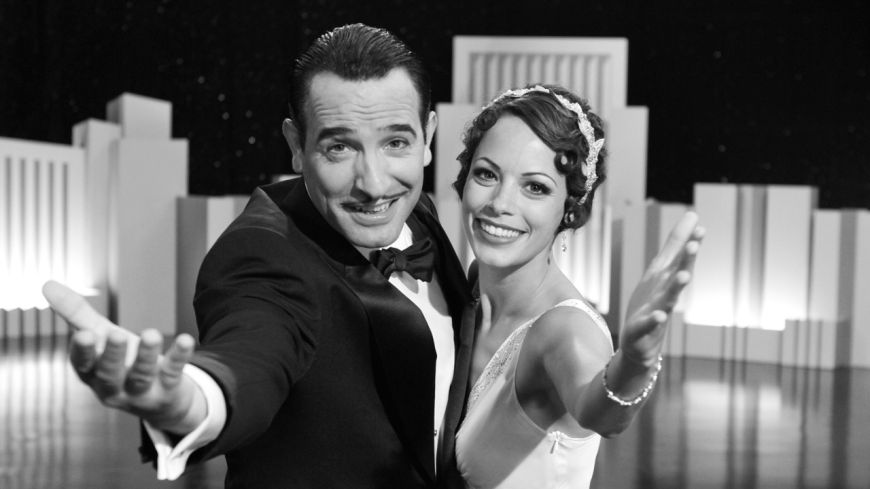
They don’t make ‘em like that anymore. Well they do now as cinema comes full circle with this delightful nostalgic breeze. Something is obviously in the air for like Martin Scorsese’s Hugo, here’s a second film in as many months as in love with the early days of cinema as well as the process of making them.
This is a proper old-fashioned black and white silent complete with dialogue captions and a stunning orchestral score. There’s not a CGI monster or exploding spaceship anywhere near this but it still has plenty of human drama to keep you hooked.
Set in the late 1920’s and early 30’s this is the story of The Artist or George Valentin (Jean Dujardin), a smouldering silent movie star on the verge of being past his onscreen prime. As his name suggests he’s part Rudolph Valentino and perhaps part Errol Flynn, a romantic lead and action hero although unlike Flynn he’s better behaved off screen.
At the premiere of his latest hit he inadvertently collides with a young wannabe starlet and their brief exchange is snapped up by the paparazzi. The following day the trade press publishes pictures of their encounter with the headline ‘Who is this mystery girl?’
Making the most of her sudden fame, mystery girl Peppy Miller (Berenice Bejo) blags her way into a small role as a background dancer. As she works her way up the ladder, Valentin repeatedly encounters her and protects her from his non-plussed boss and initially enjoys watching her career swiftly ascend.
But then The Talkies arrive. The advent of sound in films is foolishly dismissed by Valentin as a passing fad and he ploughs his personal fortune into another silent film, a vanity project that bombs just as Peppy hits the big time in a talkie. As his star wanes, hers takes off but the one thing that still links them is that they’ve held a torch for each other throughout the years.
Liberally and on occasion literally borrowing from Singin’ in the Rain and with echoes of A Star is Born, this is the story of two ships frequently passing in the night, of conflicting ideals and loyalties and ultimately of good old fashioned unspoken love.
This is a film that works both because the whole and the sum of its parts have equal weight. First off, the entire film is made in the style of an old black and white silent. It’s even presented in the old Academy Ratio of 1:33:1 (essentially a square). The locations, art direction, costumes and trappings of the silent era are perfectly concocted although it has a contemporary feel for the symbolic language of cinema, something Michael Bay missed out on in his Transformers trilogy.
For instance when Valentin meets Peppy on the stairs (of what looks like The Bradbury Building), they pause to greet each other. She’s going up, he’s going down and whilst their encounter is agreeable, the directions they head in mirror their fates. It’s this attention to detail in every shot that is marvellous yet like the best of the golden oldies it never detracts.
But the true stars of The Artist are the artists themselves. Even the walk-ons are outstanding. This is a film where photogenic expressive faces and body language count more than the ability to act but these are consummate performers creating this illusion. It’s where histrionics are not out of place but in keeping with the genre. And I hate cute funny dogs in films with a passion but even Valentin’s loyal mutt acts the pants off most modern day actors, serves the plot well and draws most of the belly laughs.
For me, although Dujardin is magnificent as Valentin, its Bejo as Peppy that is a revelation. Like the film’s storyline this is a new face that may suffer the same fate as her onscreen persona: genuine stardom. She radiates such innocent joy, kindness and effervescence as to break ones heart and it’s this contrast with Valentin’s wounded pride that makes the film. She could not have been more perfectly cast.
It’s to the filmmakers credit they resisted the temptation to introduce sound into the experience when the arrival of sound arrives as a plot device. There are however two sequences that briefly utilise it, one a nightmarish dream and another that provides a slight twist. These brief moments only serve to highlight the fact you can tell great stories with the minimum of resources. Come Oscar season, The Artist may well herald the rebirth of the old or to put it another way: stories about real people and real feelings. Take that you CGI monster!

